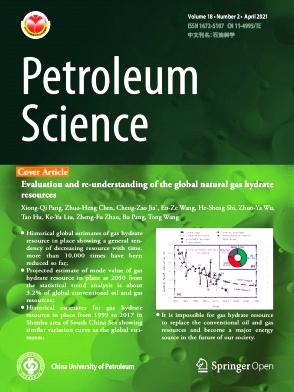Evolution of the 3D pore structure of organic-rich shale with temperature based on micro-nano CT
IF 6.1
1区 工程技术
Q2 ENERGY & FUELS
引用次数: 0
Abstract
Organic-rich shale is a significant potential source of oil and gas that requires development through in situ conversion technology. However, the evolution patterns of the internal three-dimensional (3D) pore structure and kerogen distribution at high temperatures are not well understood, making it difficult to microscopically explain the evolution of the flow conductivity in organic-rich shale at high temperatures. This study utilizes high-resolution X-ray computed tomography (micro-nano CT) to obtain the distribution of pores, kerogen, and inorganic matter at different temperatures. Combined with the pyrolysis results for the rock, the evolution of the pore structure at various temperatures is quantitatively analyzed. Based on three-phase segmentation technology, a model of kerogen distribution in organic-rich shale is established by dividing the kerogen into clustered kerogen and dispersed kerogen stored in the inorganic matter and the pores into inorganic pores and organic pores within the kerogen skeleton.
The results show that the inorganic pores in organic-rich shale evolve through three stages as the temperature increases: kerogen pyrolysis (200–400 °C), clay mineral decomposition (400–600 °C), and carbonate mineral decomposition (600–800 °C). The inorganic pores porosity sequentially increases from 3% to 11.4%, 13.1%, and 15.4%, and the roughness and connectivity of the inorganic pores gradually increase during this process. When the pyrolysis temperature reaches 400 °C, the volume of clustered kerogen decreases from 25% to 12.5%. During this process, the relative density of kerogen decreases from 9.5 g/cm3 in its original state to 5.4 g/cm3, while the kerogen skeleton density increases from 1.15 g/cm3 in its original state to 1.54 g/cm3. Correspondingly, 7%–8% of organic pores develop within the clustered kerogen, accounting for approximately 50% of the volume of clustered kerogen. In addition, approximately 30% of the kerogen in organic-rich shale exists in the form of dispersed kerogen within inorganic matter, and its variation trend is similar to that of clustered kerogen, rapidly decreasing from 200 to 400 °C and stabilizing above 400 °C. The results of this study provide an essential microscopic theoretical basis for the industrial development of organic-rich shale resources.
基于微纳CT的富有机质页岩三维孔隙结构随温度的演化
富有机质页岩是一种重要的潜在油气资源,需要通过原位转化技术进行开发。然而,由于对富有机质页岩内部三维孔隙结构和干酪根在高温下的分布演化规律还不太了解,难以从微观上解释富有机质页岩高温下的导流演化。本研究利用高分辨率x射线计算机断层扫描(微纳CT)获得不同温度下孔隙、干酪根和无机物的分布。结合岩石的热解结果,定量分析了不同温度下孔隙结构的演化。基于三相分段技术,将富有机质页岩的干酪根划分为聚集性干酪根和分散于无机物中的干酪根,将干酪根骨架内的孔隙划分为无机孔隙和有机孔隙,建立了富有机质页岩干酪根分布模型。结果表明:随着温度的升高,富有机质页岩无机孔隙的演化经历了干酪根热解(200 ~ 400℃)、粘土矿物分解(400 ~ 600℃)和碳酸盐矿物分解(600 ~ 800℃)三个阶段;无机孔隙度从3%依次增加到11.4%、13.1%和15.4%,无机孔隙的粗糙度和连通性逐渐提高。当热解温度达到400℃时,团簇干酪根体积由25%下降到12.5%。在此过程中,干酪根的相对密度从原始状态的9.5 g/cm3下降到5.4 g/cm3,而干酪根骨架密度从原始状态的1.15 g/cm3增加到1.54 g/cm3。相应的,有7% ~ 8%的有机孔隙发育在簇状干酪根内,约占簇状干酪根体积的50%。富有机质页岩中约30%的干酪根以分散干酪根形式存在于无机物中,其变化趋势与团簇干酪根相似,在200 ~ 400℃范围内迅速减少,在400℃以上趋于稳定。研究结果为富有机质页岩资源的产业化开发提供了重要的微观理论依据。
本文章由计算机程序翻译,如有差异,请以英文原文为准。
求助全文
约1分钟内获得全文
求助全文
来源期刊

Petroleum Science
地学-地球化学与地球物理
CiteScore
7.70
自引率
16.10%
发文量
311
审稿时长
63 days
期刊介绍:
Petroleum Science is the only English journal in China on petroleum science and technology that is intended for professionals engaged in petroleum science research and technical applications all over the world, as well as the managerial personnel of oil companies. It covers petroleum geology, petroleum geophysics, petroleum engineering, petrochemistry & chemical engineering, petroleum mechanics, and economic management. It aims to introduce the latest results in oil industry research in China, promote cooperation in petroleum science research between China and the rest of the world, and build a bridge for scientific communication between China and the world.
 求助内容:
求助内容: 应助结果提醒方式:
应助结果提醒方式:


